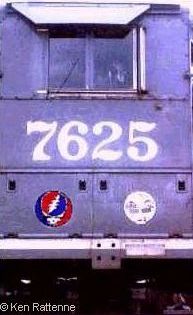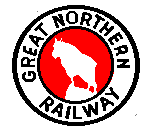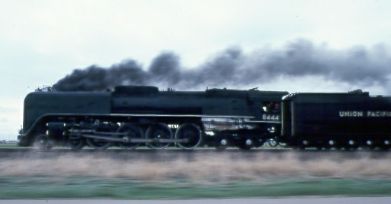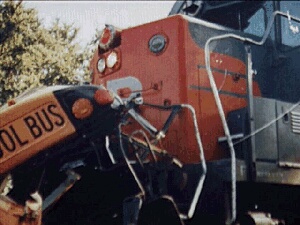"...Like a steam locomotive rolling
down the track,
He's gone and nothing's gonna bring him back"
 The
Railroad As Metaphor
The
Railroad As Metaphor
An Essay By Ken Rattenne
for the Annotated
Grateful Dead Lyrics
By David Dodd
Kraemer Family Library, University of Colorado at Colorado Springs
Exclusive to the Annotated Grateful Dead Lyrics Page
©1997-2010 by Ken Rattenne (krattenne@sbcglobal.net)
Last updated 5/29/2010
"I
Wish I was a headlight on a northbound train,
I'd shine
my light in the cool Colorado rain"
-- Lyric from "I Know You Rider,"
traditional folk-blues song |
Introduction
 |
Casey Jones Lives! Southern
Pacific 7625 at Tracy, CA. 1995.
(Photo by Ken Rattenne) |
met·a·phor
1.
A figure of speech in
which a word or phrase that ordinarily
designates one thing is used to designate
another, thus making an implicit
comparison, as in “a sea of troubles”
or “All the world's a stage” (Shakespeare).
2. One thing conceived as representing
another; a symbol.
- American Heritage Dictionary
|
| What's a "railfan."While
many of us are captured by the romance and intrigue offered by trains,
"railfans" go the extra mile ( so to speak) by "chasing" trains, sometimes
for hundreds of miles;. they photograph railroad equipment and subjects
to the exclusion of all else, and generally are totally engrossed
in their hobby of choice. Sound familiar eadheads? |
 nyone
exposed to the Grateful Dead beyond idle curiosity or peer pressure is
familiar with the band's rendering of the traditional folk-blues song "I
Know You Rider." The quoted lines reference the desire of the singer
to leave sadness behind and seek greener pastures elsewhere. In a clever
use of metaphor, the song's unknown author wrote this verse using the railroad
to enhance the imagary of the lyric and thus communicate his message more
clearly.
nyone
exposed to the Grateful Dead beyond idle curiosity or peer pressure is
familiar with the band's rendering of the traditional folk-blues song "I
Know You Rider." The quoted lines reference the desire of the singer
to leave sadness behind and seek greener pastures elsewhere. In a clever
use of metaphor, the song's unknown author wrote this verse using the railroad
to enhance the imagary of the lyric and thus communicate his message more
clearly.
It's no coincidence that folk, blues and even country music writers
have used railroad references in their songs since the advent of the steel
wheel on steel rail. Yet it's a use of metaphor that remains today a strong
source of emotion in both the fine and performing arts fields.
Musicians have traditionally used the railroad as metaphor to conjure
images of everything from heartbreak and sorrow to hope, happiness and
even religious deliverance. Which brings us to the Grateful Dead: When
reviewing the Dead's repertoire of songs (both recorded and performed)
it becomes apparent that the "lads" played more than their fair share of
"train songs." Whether coincidentally or by intent, the fact remains that
the band employed more metaphorical railroad references than any other
type of "recurring-theme" image, including the much loved "Rose." In fact,
(and I go out on a limb here) one could make the argument that, as of 1996,
the Dead used the railroad metaphor more than any other recording group
in the United.States.
The Dead's railroad songs (for lack of a better term) can be divided
into two major groups consisting of songs where:
-
The railroad theme is paramount to the tune.
-
The railroad is used merely in passing as a metaphorical reference
Now you may ask yourself "Gee, were the band members railfans (see
sidebar). Most likely not. In fact, this writer purports the band
was mostly, if not completely, unaware that they had built such a large
railroad repertoire.
A Look At The Songs
The focus of this monograph is the use of railroads as metaphor by the
Grateful Dead. It should be noted that Robert Hunter penned several tunes
with a strong railroad theme that were not recorded by the band and thus
will not be covered here.
We also won't examine any of the "cover" tunes performed or recorded
by the band, you can visit the Roots Of The Grateful Dead web page to do
that. The only exceptions are Jesse Fuller's "Beat It On Down The Line",
and "The Monkey And The Engineer", and I only present the lyrics with no
discussion.
In addition, due to space limitations only a select few of the many
songs listed in the below table will be discussed. With this restriction
noted, presented below is a table of the better-known tunes containing
railroad references.
The best-known Grateful Dead train song is obviously "Casey Jones." Now
here is a real rootin' tootin' railroad tune, right down to the driving
rhythm the band uses to crescendo the end of the song (my favorite version
is the one that appears on the Last Days Of The Fillmore album).
Robert Hunter has crafted a nasty little tune that can only be described
as a paradox. Garcia married an upbeat rythym and happy melody to Hunter's
disasterous tale of a coke-tootin, whistle-blowin' locomotive engineer
that would drive any modern-day (railroad) rules examiner1
to an easy ulcer.
The song is somewhat of parable: Metaphor wrapped in just enough authenticity
to connect us to the traditional folk song of the same name. Of course,
the chances that Casey actually used cocaine is rather slim, as alcohol
tended to be the drug of choice to railroad men in those days. Of course,
today the railroad companies have very aggressive drug detection and prevention
programs in place to prevent just the sort of thing that happened to poor
old Casey (in the Dead's song, that is). But even today the tragedy that
belongs to Casey Jones, mainly plowing into another train on the same track,
still occurs today.
1The universal railroad
rule covering drinking on the job and the use of controlled substances
while on duty is called Rule G. In our subject song Casey has very definetely
violated Rule G!
Top
These two tunes, recorded long ago on Anthem Of The Sun use
railroad references in their titles only! The first, penned by Ron McKernan,
is "Caution (Do Not Stop On The Tracks)". This song has been around so
long its beginnings have become obscured. Nonetheless, the title refers
to signs commonly seen at railroad grade crossings across America.
It's interesting but not surprising to note that Ron Pigpen McKernan,
"Mr. Pen" as Janis Joplin called him, should use a railroad reference in
an original work as early as 1965. I say not surprising because Pigpen's
background and main musical influences were heavily steaped in the Blues.
And guess which musical genre borrowed heavily from the railroad idiom?
You got it...the Blues.
Unprotected grade crossings are grade crossings with no automated crossing
gate or arm to lower and block the roadway upon the approach of a train*.
Unprotected crossings also displayed the once common "Stop-Look-Listen"
slogan which is now a part of American folk history. Even today Do
Not Stop On The Tracks signs can occasionally still be found at some
of the more rural grade crossings..
As for New Potato Caboose (by the late Robert Peterson), suffice
it to say that this song came out of the "Owsley" period! Although, the
Mr. Potatohead people could have a new marketing opportunity. "Mr. Potato
Caboose." (For a more serious discussion of this song see the annotated
lyrics by clicking on the song title above)
Top
*Before the advent of automatic crossing gates, busy grade
crossings (usually in lthe larger metropolitan areas) had crossing shantys
with a railroad employee who would go out and stop traffic upon the approach
of a train. These employees were often close to reitrement age, or in fact
had "retired" and simply worked for the extra money.
In Jack Straw Hunter's reference to railroads is made in the third
verse:

The Great Northern emblem
featured "Rocky" the mountain
goat. |
Catch the Detroit Lightning
Out of Santa Fe
Great Northern out of Cheyenne
From sea to shining sea
Gotta get to Tulsa
First train we can ride
Got to settle one old score
And one small point of pride
Both metaphor and artist's license are used heavily in this piece of verse.
As pointed out elsewhere in these pages, Daniel Dawdy wrote to David
Dodd "The Great Northern
was not a train, but a large railroad which ran from St. Paul to Portland,
Seattle and Vancouver. There was no train called the Great Northern
that I know of."
Correct. But let's keep in mind that blues, country and rock song writers
are generally
not railfans and thus tend to write from what they
have seen and experienced. They also tend to write whatever will sound
good to get the lyric to fit the music.
Thus in the case of Jack Straw, Robert Hunter, who probably never
picked up a Trains
or Railfan magazine
in his life (correct me if I'm wrong Robert), may have remembered seeing
a locomotive, or more probably, a freight car with the Great Northern name
or herald on its' side; maybe he was in Cheyenne at the time...
One can see the possibilities.
And even though the Great Northern railroad was merged into the Burlington
Northern railroad in 1970 (and more recently the Burlington
Northern Santa Fe --or BNSF), the colorful and distinctive GN herald
and name can still be seen on an occasional boxcar even today.
To this writer, Jack Straw represents one of the best examples
of railroad symbology found in the Dead repetoire.
Top
These two songs use references to locomotives in a purely metaphorical
sense.
"He's Gone"
In "He's Gone" Hunter wrote...
"Like a steam locomotive rolling
down the track,
He's gone and nothing's gonna bring
him back"
...referencing (according to David Dodd in his annotated lyric page for
this song) the disappearance of steam as a means of locomotion for trains.
Steam engines were gone from mainline railroads by 1960 when the Norfolk
& Western (now part of the Norfolk Southern) retired their last steam
power from freight service.
However, this writer's interpretation of the line is different. If anyone
has seen one of these big, mainline steam locomotives in excursion service
(such as former Southern Pacific 4449 or one of Union Pacific's two big
steam engines, Nos. 844 and 3985), then the impression of immense power
as one of these behemoths blasts by at 60 mph is obvious. And when it's
gone -- it's gone!
Case in point: In 1984 reporter Marie Watkins of the New Haven (Missouri)
Leader wrote a column for her newspaper after experiencing Union
Pacific 8444 (now UP 844) passing through her small town on a winter's
day:
| "It snowed
on Monday, March 12, the wind was biting and the day was dull, dull and
gray. We remembered about old No. 8444 and shuffled up to the crossing
to wait for the old steam engine...just out of respect for the past.
"The cold quickly
stung our toes with pain, and the people who strung along the track wandered
here and there and stomped their feet. A train or two passed, but there
was no sign of the old steam engine with the cow catcher.
"We milled
about, that half-hearted gathering of the cold and the curious. Over there
was Mr. Williams...wait...
"A hoarse whistle
moaned...Lord! MERCY! It was unbelievable! ""Old" 8444 exploded across
the Front Street track like a page from Armageddon.
It would be
inappropriate to say the old geezer was smoking - she was breathing fury
like a black demon. You'd a thought she was mad at somebody. And m-o-v-i-n-g?
That iron monster never heard of chug-a-chug. She hit with such blithering
force that it caused terror to rise up and go forth. Black thunder swept
all breath away and the air roared with mocking anger.
"A hunnert
miles and hour! A hunnert miles an hour!" the people would say later with
disbelief, for the wind from 8444 blew one onlooker right off the railroad
crossing.
"Before she
even got here, No. 8444 was gone!
It was awesome,
just awesome."
- Marie
Watkins, 1984
Reprinted from
a Union Pacific promotional piece. |

Union Pacific 8444 (now
UP 844) Ken Rattenne Photo |
I rest my case!
So which interpretation of this single line in this one song is really
correct?
Both. Neither. I suspect that Hunter is the only one who really knows
why he penned any line in any song. However, a well written song is like
a well written story, allowing the listener to become personally involved
with the the music and lyrics. Dead tunesmiths were masters at this.
Top |
"They Love Each Other"
In a completely different vein, when Garcia sings...
 "You
better not be there when it rolls over..." Altercation
between a schoolbus and a Southern Pacific diesel in Arkansas did not fare
well for the occupants.. (Courtesy Arkansas Operation Lifesaver) "You
better not be there when it rolls over..." Altercation
between a schoolbus and a Southern Pacific diesel in Arkansas did not fare
well for the occupants.. (Courtesy Arkansas Operation Lifesaver) |
"It's nothing they explain,
it's like a diesel train --
You better not be there
when it rolls over..."
There's that "coming and going" metaphor again. Just like the lyric
in "He's Gone" Hunter uses the image of a locomotive to communicate
strength and power in order to get his point across. This time it's a diesel.
This lyric is not only illustrative but subtly instructive too. We all
know (or should know) not to get in the way of a train (remember
Caution Do Not Stop On The Tracks?) ; they're big, heavy and they
don't stop very well
 According
to Operation Lifesaver, Inc a car traveling 55 mph needs approximately
200 feet to stop; a train traveling at 55 mph needs over a mile to stop!
No doubt this line from "They Love Each Other" could easily be adopted
by the Operation Lifesaver folks as part of their grade crossing safety
message.
According
to Operation Lifesaver, Inc a car traveling 55 mph needs approximately
200 feet to stop; a train traveling at 55 mph needs over a mile to stop!
No doubt this line from "They Love Each Other" could easily be adopted
by the Operation Lifesaver folks as part of their grade crossing safety
message.
With that established, the railroad metaphor in this song simply communicates
the unstoppable love that exists between this couple (sigh sigh).
Top
 |
| A reader of this essay forwarded to me this scan of a
sticker issued to advertise the the Canadian Festival Express. See
the official web site. |
Just about everyone knows this tune is about the
Dead's 1970 Canadian Festival Express tour with Janis Joplin, The
Band and several others. The tour's entourage rode a chartered passenger
train across Canada, shunning the usual travel arrangements by bus or plane.
The lyrics describe to a tee the party-like, anything-goes atmosphere
of riding a chartered train or private railroad car (PV), which is to say,
fun, fun, fun! This author has traveled thousands of miles on PVs over
the years and there is nothing like it in the travel industry. In the Dead's
case of though, they had an entire train chartered for this tour.
The Film Janis is reported to include footage from this storied
tour but mostly the details of the train trip were word-of-mouth. Finally,
in 2003, the original producers of the Festival
Express tour released a 2-disc DVD chronicling this important event.
The Festival Express was a chartered train that traveled over Canadian
National rails to deliver the tour's acts to their various venue locations.
Today, chartering a train in Canada would be impossible. Canadian passenger
operations are now under an Amtrak-like company called Via Rail Canada,
which reportedly will not allow private cars on their trains let alone
rent an entire passenger consist to a bunch of rowdy rock bands! In the
U.S., however, there are many private car operators who would be
more than willing to take a band's money for a grand cross-country trip.
Top
One of the most haunting and mysterious songs performed by the Dead, Terrapin
Station evokes incredible imagery, little of it referencing trains.
Interesting, since the title of the song suggests a heavy railroad influence.
But then, that's part of the wonder of this song. The song title itself
is curious: Terrapin Station The American Heritage dictionary defines the
word "terrapin" as "Any of various North American aquatic
turtles of the family Emydiolae, especially the genus Malaclemys, which
includes the diamondback terrapin."
Hmmmm. And they have their own station?
Aside from the name Terrapin Station, there is but a single lyrical
railroad reference in the entire song, and this nearly three quarters of
the way through the song's lyrics.
Terrapin Station
in the shadow of the moon
Terrapin Station
and I know we'll be there soon
Terrapin - I can't figure out
Terrapin - if it's an end or the
beginning
Terrapin - but the train's got its
brakes on
and the whistle is screaming: TERRAPIN
While the last two lines are the only hard reference to trains in this
entire e entire song, the words chosen, and they way they are phrased are
a compelling message to the listener; a frantic sense that something's
about to happen...and the Dead's instrumental might becomes dynamic and
driven. Though not as rythmically dynamic as the final bars to Casey
Jones, the instrumental performance does give one the sense of riding
a speeding train.
Only at the last lyrical refrain at the songs conclusion we are allowed
to drift down onto a melodic plateau at the part of the song Hunter dubs
AT A SIDING.
Terrapin Station almost didn't make it on my list, but that would
shortchange a truly great song, and the most extraordinary of all train
songs included the Dead's repertoire.
Top
This is Brent Mydland's contribution to the pool of "Ded Train Songs."
There's little doubt as to Brent's intent with this song. He even
begins the studio version of this tune with the sound of an approaching
train. In the tradition of Blues writers everywhere, Brent uses the metaphor
of a train (specifically a diesel locomotive) to describe romantic woes.
The title (obviously) refers to the weight of a diesel locomotive and
it's train. In fact, the modern diesel found on today's freight railroads
generates between 3800-4400 hp, holds around 5,000 gallons of fuel, measures
70-plus feet in length, and weighs -- a lot!
As a point of trivia, the sound effect heard in the opening of the studio
track on In The Dark is one of the CalTrain
diesels used in commuter service between San Francisco and San Jose, California.
Stands to reason: If you needed a recording of a diesel, what better place
to obtain one than a short drive across the Bay to San Francisco and the
CalTrain station at 4th and Townsend? Especially when you realize 60 trains
a day arrive and depart in a 24-hour period.
Top
Conclusion
More could certainly be written on the subject of the Grateful Dead
and railroads. Though there are additional songs that would be interesting
to cover (Passenger, The Monkey and the Engineer etc), I
believe I've illustrated the point enough to invite you to compile your
own list of Dead railroad songs. In fact, if you do, please send me a copy
so I can compile a master list.
Looking beyond the Dead experience one can discover literally hundreds
of songs by folk, blues, rock and country artists employing the railroad
as a primary metaphoric theme in their music. Even John Denver released
an all-railroad themed album in 1997 not long before his death (I know
this because a well-intentioned cousin sent me a copy). And you can bet
that should the steel wheel ever disappear as a viable mode of transportation
(not a probability!) the train, with its moaning whistle, thunder and power,
will continue to live in song and folklore!
And please remember, Do Not Stop On The Tracks!
Ken Rattenne
Modesto, Calif.
Reach Ken at krattenne@sbcglobal.net
Last updated Sept 2010
Top
 The
Railroad As Metaphor
The
Railroad As Metaphor



 "You
better not be there when it rolls over..." Altercation
between a schoolbus and a Southern Pacific diesel in Arkansas did not fare
well for the occupants.. (Courtesy Arkansas Operation Lifesaver)
"You
better not be there when it rolls over..." Altercation
between a schoolbus and a Southern Pacific diesel in Arkansas did not fare
well for the occupants.. (Courtesy Arkansas Operation Lifesaver) According
to Operation Lifesaver, Inc a car traveling 55 mph needs approximately
200 feet to stop; a train traveling at 55 mph needs over a mile to stop!
No doubt this line from "They Love Each Other" could easily be adopted
by the Operation Lifesaver folks as part of their grade crossing safety
message.
According
to Operation Lifesaver, Inc a car traveling 55 mph needs approximately
200 feet to stop; a train traveling at 55 mph needs over a mile to stop!
No doubt this line from "They Love Each Other" could easily be adopted
by the Operation Lifesaver folks as part of their grade crossing safety
message.
